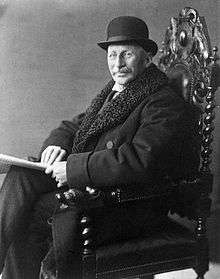Charles Edward Keyser
| Charles Keyser FSA | |
|---|---|
 Keyser in the 1910s | |
| Born |
Charles Edward Keyser 10 September 1847 |
| Died |
23 May 1929 (aged 81) Aldermaston, Berkshire |
| Resting place | Church of St Mary the Virgin, Aldermaston |
| Residence | Aldermaston Court |
| Alma mater | Trinity College, Cambridge |
| Occupation | Stockbroker |
| Title | Lord of the Manor of Aldermaston |
| Term | 1893–1929 |
| Predecessor | Daniel Higford Davall Burr |
| Spouse(s) | Mary Emma Bagnall |
| Children | 3 |
| Parent(s) | Charles Keyser and Margaret Blore |
| Relatives | Edward Blore (maternal grandfather) |
Charles Edward Keyser FSA[1] (10 September 1847 – 23 May 1929[2]) was a British stockbroker and authority on English church architecture.[3] In his later life, he became Lord of the Manor of Aldermaston in the English county of Berkshire.
Biography
Charles Keyser was born in Paddington, London, to financier Charles Keyser (d. 1892) and Margaret Blore (daughter of Edward Blore).[3][4] Keyser attended Eton College, before studying Law at Trinity College, Cambridge. He gained his B. A. in 1870 and his MA in 1873.[3] Keyser joined Colne Valley Water, becoming the chairman.[5] At this time, he lived at Warren House in Stanmore with his sister, Agnes. Leaving Warren House in approximately 1890, Keyser bought Merry Hill House in Bushey. While living in Hertfordshire, he captained the Hertfordshire County Cricket Club for eight years.[3] After his studies, Keyser worked in the City of London as a stockbroker, building great wealth.[6]
In 1879, Keyser was appointed as a Fellow of the Society of Antiquaries due to his writings and lectures on English church architecture. In 1883, he wrote for the South Kensington Museum about buildings in Great Britain with mural paintings.[3] He became president of the British Archaeological Association in 1906, a post he held until his death. In his obituary in the Association's Journal, he was credited with reviving the Association's fortunate and he was an extraordinarily active president, publishing many papers in the Association's Journal.
In 1893, Keyser purchased Aldermaston Court, a neoclassical mansion and estate in the Berkshire village of Aldermaston.[3] The manor house was built in the mid-19th century by Philip Charles Hardwick,[7] a student of Keyser's maternal grandfather.[8] Keyser had been told of the estate's sale by his sister, Agnes, who said that it reminded her of her stay at Sandringham House.[6] He was the benefactor of numerous projects in the village, including the renovation of the church, establishment of a water supply and drainage system, and building of a parish hall.[3] While in Aldermaston, Keyser was involved with the South African Wars, establishing a convalescent home for wounded soldiers. He later equipped the parish hall for the same purpose if its use was necessary.[3]
Keyser served as a Justice of the Peace in both Hertfordshire and Berkshire, and sat on both county councils.[3] He was, at various times, Deputy Lieutenant[9] and High Sheriff of Berkshire.[3]
Keyser was a freemason and Knight Templar.[10] He was Grand Warden of England and Deputy Provincial Grand Master of Hertfordshire.[3] He was also chairman of the Harrow and Reading divisions of the Conservative Association, and was treasurer of the west Hertfordshire association.[3]
Personal life
Keyser married Mary Emma Bagnall on 29 November 1871. They had one son, Charles Norman (1885–1964),[4][11] and three daughters: Dorothy Margaret (1884–1963), Muriel Agnes (1886–1977) and Sybil Violet (1889–1966).[4] In the 1891 census, all four Keyser children were listed as living at St George Hanover Square. In the following census, Keyser's daughters were recorded at 37 Portman Square.[4]
See also
Footnotes
- ↑ Society of Antiquaries of London (1920, p. 281)
- ↑ Venn, John (1922). Alumni Cantabrigienses: A Biographical List of All Known Students from the Earliest Times to 1900 (2 ed.). Cambridge, UK: Cambridge University Press. p. 35. ISBN 1108036147. Retrieved 5 September 2014.
- 1 2 3 4 5 6 7 8 9 10 11 12 Anonymous (1913, p. 97)
- 1 2 3 4 Stock & Stock (2011)
- ↑ Baker (1976, p. 99)
- 1 2 Sermon (2005)
- ↑ Fawcett (1977, p. 44)
- ↑ Allinson (2008, p. 125)
- ↑ "No. 27315". The London Gazette. 21 May 1901. p. 3468.
- ↑ Anonymous (1913, p. 99)
- ↑ Anonymous (1913, p. 100)
Sources
- Allinson, K (2008), Architects and Architecture of London, Oxford, Oxfordshire: Architectural Press, ISBN 0-7506-8337-6, retrieved 23 May 2011
- Anonymous (1913), Representative British Freemasons (REPRINT), London: Kessinger Publishing, retrieved 23 May 2011
- Baker, T F T (1976), The Grove, Great Stanmore – Extracts from a History of the County of Middlesex, 5, Provo, Utah: Ancestry.com, retrieved 24 May 2011
- Fawcett, J (1977), Seven Victorian Architects, University Park, Pennsylvania: Pennsylvania State University Press, retrieved 23 May 2011
- Sermon, D (2005), Masonic Paintings in a Berkshire Church, London: Grand Lodge Publications, archived from the original on 18 June 2010, retrieved 23 May 2011
- Society of Antiquaries of London (1920), Proceedings of the Society of Antiquaries of London, London: The Society
- Stock, J; Stock, R (2011), Ancestors of the Kay, Star, Steel(e) and Stock Families, Milton Keynes, archived from the original on 2 April 2012, retrieved 11 September 2011
| Honorary titles | ||
|---|---|---|
| Preceded by Henry Gold |
High Sheriff of Berkshire 1898–1899 |
Succeeded by Charles Thomas Daniell Crews |